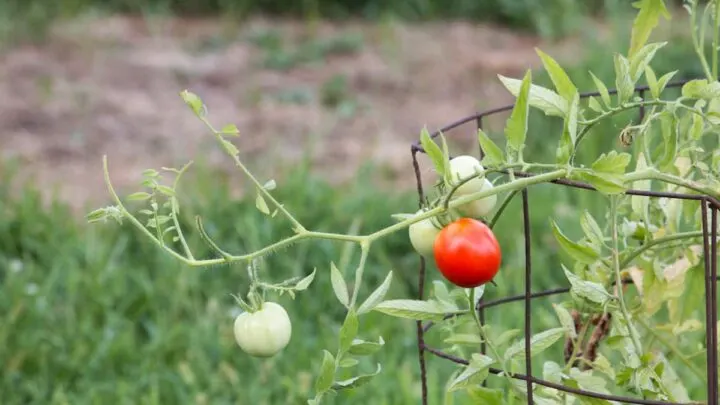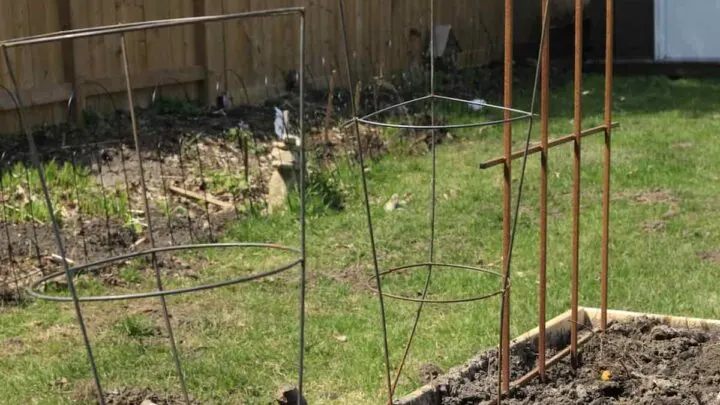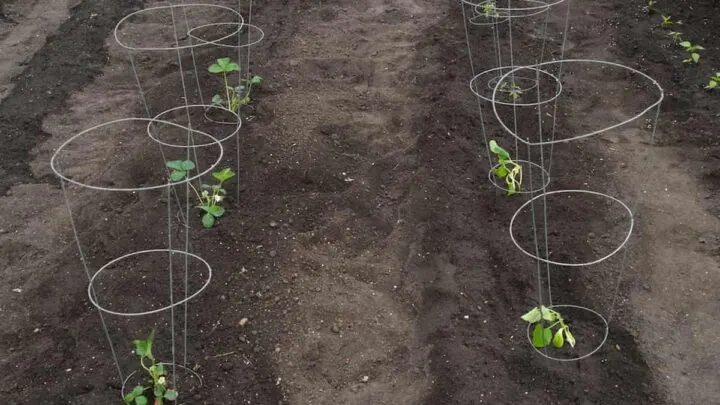When you think of planting tomatoes, you may think about tomato cages. It’s a natural progression – and tomato is in the name. Supporting your plant is important, and cages are one of the many ways to do that effectively.
Tomato cages are wonderful additions to certain types of tomato plants. With all the kinds of tomato cages available, you’re sure to find something to help your tomato plants grow.
Having grown tons of tomatoes in the garden, I figured it may be helpful to make a guide for new and established gardeners on how to use tomato cages the best way. We’ll get into the various shapes of cages, different materials, and even how to properly install them into the soil. We’ll even discuss some of the varieties that benefit the most from tomato cages.
With that in mind, let’s get right into it!

Shapes Of Tomato Cages
Two shapes are popular for tomato cages: circular and triangular. You can easily find these in any garden center, and they are relatively inexpensive.
The purpose of both shape cages is the same; support the plant as it grows. Yet the shapes can provide different pros and cons.
Circular Or Ring Cages
Ring tomato cages are also known as circular tomato cages. These are the most common kind of tomato cages you find when going to the store.
Ring tomato cages usually have one or three stakes with a series of rings. There are between 1 and 3 rings on the tomato cages, but there could be more depending on the cage style.
Ring tomato cages can often be the cheapest option for tomato cages because it is so little to them.
However, these tomato cages can be more convenient than any other kind of cage because some types are made to be folded flat. This may not be seen as useful upon first thought, but when you store your tomato cages at the end of the growing season, you’ll be thanking someone that they fold up so easily!

Triangular Cages
Though less common than circular or ring tomato cages, there are also triangular cages. They are the same as ring tomato cages, but they have a different shape: a triangle.
I don’t see how there can be that much of a difference from ring tomato cages, but there are gardeners who swear that triangular tomato cages are sturdier.
The major difference between ring and triangular cages is that triangular cages are not usually as tapered as ring tomato cages.
On a circular tomato cage, the bottom ring is the smallest, and the top ring is the largest to accommodate the leaves of your tomato plant. Conversely, triangular cages are the same size from top to bottom.
The regular shape of the triangular tomato cages may be what makes for a sturdier cage for your tomatoes.

Materials Used For Tomato Cages
You have more variety regarding the material of the tomato cages.
The following materials used are placed from least sturdy to most sturdy:
Plastic
Plastic is not a common material for tomato cages, but you can sometimes find cheap tomato cages made out of plastic.
These cages can help in a pinch, especially if you need to save money, but they also have several drawbacks, such as:
- Not lasting more than one season
- Not being able to handle the weight of your tomatoes or other plants
- Not able to withstand the elements
The last thing you want is for one of the rings to snap off the stake with this cheaply made tomato cage!
Mesh
When we talk about mesh, we are talking about wire mesh, which is not as sturdy as standard wire.
Wire mesh is used most often in homemade tomato cages. The mesh is secured to wooden stakes.
Wire mesh does a fine job of securing tomatoes, but the mesh is inherently not as strong as other types of metals. Your wire mesh may be able to last a season – or even two if you are lucky – but homemade wire mesh tomato cages are not a long-term solution for avid tomato growers.
Wood
Wooden tomato cages are a homemade project as well.
Since wood cannot always be bent into an arc shape, wooden tomato cages are triangular or square to make the job simple and easy.
Wood is a fine material for sturdiness, but the wood should be treated to ensure that it can withstand the elements, including sun and regular watering for the tomatoes.
Raw wood can begin to rot if it is constantly wet and can attract pests that can infest your tomatoes.
Wire
Wire is one of the most popular materials for tomato cages because it is sturdy, dependable, and affordable.
You can find bare wire tomato cages, but most tomato cages will also have a plastic coating to avoid the metal wire from rusting out.
Wire tomato cages do their job just fine but are still prone to bending. Your tomato can bend the wire with weight, but most damage comes from storage.
You aren’t a true tomato gardener until you’ve had to wrestle your wire tomato cages out of your shed after a long, cold winter!
Steel
The best material for tomato cages is steel because it is strong. The drawback here is that steel will be more expensive than other materials like wire.
Steel tomato cages may be worth the higher cost upfront because they will:
- Last longer than traditional wire tomato cages
- Bear more weight than most other types of tomato cages
- Be less prone to rusting as opposed to wire tomato cages
- Not attract pests as wood tomato cages may

How To Install Tomato Cages
Regardless of the type and material of tomato cage that you end up with, the installation will be similar.
You will install tomato cages differently in soil than you will in a container, but thankfully, tomato cages can be universally used wherever you decide to plant your tomatoes.
In Soil
Installation of tomato cages in soil is easy.
Put your tomato cage around your tomatoes before the plant matures. It will be easier to put a cage around a small plant than a mature plant because you will not need to wrestle with the leaves.
Position the cage around the tomato, so the plant is in the center of the stakes.
Use your foot or hands to press the stakes into the ground. You do not need to push it so far that the bottom rung is pushed into the dirt; push the cages into the dirt until they feel sturdy.
Be careful when you are putting the cage into the ground, especially if the ground is hard. Too much pressure will snap your tomato cage!
In Containers
The process for putting a tomato cage in a container is the same.
The critical part here is that your container is deep enough to drive the stakes into. Soil in a container is looser than the earth in the ground, so you will need to ensure that your tomato cage is sturdy.
To ensure that your tomato cage will not rip out of the pot, I suggest planting your tomatoes in a pot or container that is about the same size as the bottom of the tomato cage. This will give your cage a snug fit, so it won’t have enough room to rip out of the container.
Pros Of Using Tomato Cages
There are several pros of using a tomato cage:
- Your tomato’s foliage will be lifted off the ground, preventing rot and pest infestation
- Your tomatoes will be easier for you to pick when they are ready to be harvested
- Your tomatoes won’t spoil as fast
- The tomato cage will bear some of the weight of the tomatoes, thus making it less likely that the plant will fall over
Cons Of Using Tomato Cages
As with anything else, there are cons of using tomato cages that should also be mentioned:
- You will need to purchase either the cages themselves or the materials to make them; this can sometimes be a yearly expense depending on the quality of the cage
- The tomato cages can break easily and usually from human error
- Tomato cages do not prevent rot or infestation
- The tomato cages can bend with the weight of the tomato
Tomato cages do a lot of good for tomatoes, but your tomatoes can indeed grow without tomato cages. Weigh the pros and cons of growing tomatoes with tomato cages to decide what the best option is for you.
Tomato Varieties That Benefit From Tomato Cages
Varieties of determinate tomatoes can benefit the most from tomato cages.
Determinate tomatoes reach a certain size and stop growing, which means that the plant will bear all its fruit at once. The weight of the tomatoes can become more than the tomato plant can handle without a cage for extra support.
Roma Tomatoes
Roma tomatoes are perhaps the most popular determinate tomato variety.
This plant will grow until all of its tomatoes are ready to harvest simultaneously.
Roma tomatoes aren’t large – usually about 3 inches large – but they are denser than some other varieties of tomato because they have a thicker wall and less juicy. Since they are denser, they can be heavier.
In this instance, a tomato cage will support the plant and its foliage until you can pick all of the tomatoes.
Rutgers Tomatoes
Rutgers tomatoes, which are also determinate, are known for their productivity, so it is extra important that this variety of tomatoes has a tomato cage.
This variety has a high yield, so you can expect that you will have more tomatoes than you know what to do with when this tomato is ready to harvest!
You may also notice that the Rutgers tomato will also have a few other waves of fruiting, so the tomato cages will support its stems as it nears the end of its growing season.
Celebrity Tomatoes
Celebrity tomatoes have that name for a reason: they are a popular choice because of their flavor!
Compared to the other two tomato varieties on this list, the Celebrity tomato plant is going to give you the largest tomatoes – and, again, all at once! – so, of course, the plant needs a little extra support from a well-made tomato cage.
One other thing to note is that this may happen again and again. Even though the Celebrity tomato is considered determinate (or semi-determinate), it will produce large harvests over and over until the first frost of the season.
You’ll get your money’s worth out of a tomato cage when it comes to the Celebrity tomato!

Hi there, my name is Allie and welcome to my blog; GareningWithAllie!
Much of what you see written here is just our personal experiences with gardening. Along with the content I write here, there is also a unique collection of gardening topics covered by some of our close friends. I hope you find everything you read here to be helpful, informative, and something that can make your gardening journey the most lovely experience ever! With that said, Happy Gardening!
